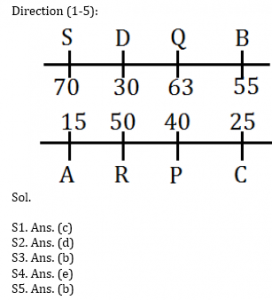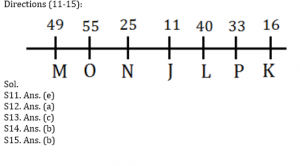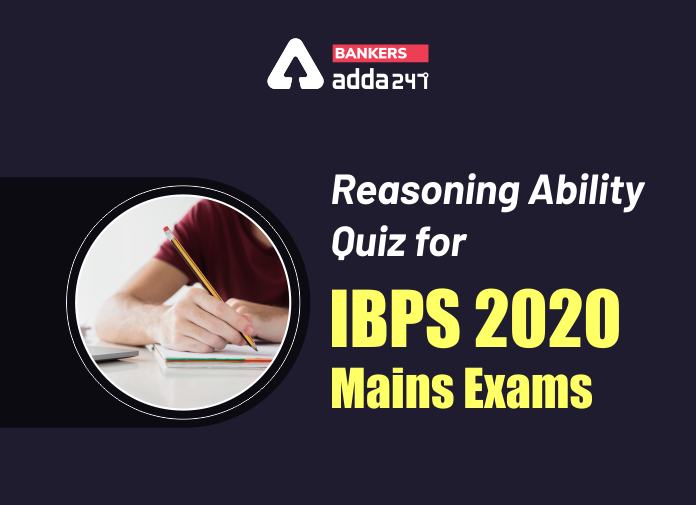Directions (1-5): Study the following information carefully and answer the questions given below:
Eight persons i.e. A, B, C, D, P, Q, R and S are sitting in two parallel rows but not necessarily in same order. Persons sitting in one row are facing the persons sitting in another row. Persons sitting in row 1 are facing North and persons sitting in row 2 are facing South. They get different marks in the exam.
S sits 2nd to the right of the person who faces P. Persons who get minimum and maximum marks in the exam are sitting at extreme ends. Difference between the marks of Q and S is 7. Person who gets 15 marks sits 2nd to the left of the person who gets 40 marks. Person who gets 30 marks is an immediate neighbor of the persons who get 63 and 70 marks. C faces the person who gets 55 marks. Person who gets 50 marks sits immediate left of P. C gets 25 marks. B sits 2nd to the left of D. P faces North. D does not get 55 marks. R gets double marks than C.
Q1. How many marks D gets in the exam?
(a) 15
(b) 25
(c) 30
(d) 40
(e) None of these
Q2. Who among the following person gets highest marks?
(a) A
(b) Q
(c) P
(d) S
(e) None of these
Q3. What is the position of A with respect to R?
(a) Immediate right
(b) Immediate left
(c) 2nd to the right
(d) 2nd to the left
(e) None of these
Q4. Which of the following is not true regarding B?
(a) B sits at extreme end
(b) C faces B
(c) B gets 3rd highest marks
(d) Two persons are sitting between B and S
(e) All are true
Q5. If P is related to 15, C is related to 50 then, in the same order who is related to 55?
(a) S
(b) D
(c) Q
(d) R
(e) None of these
Directions (6-9): Study the following information carefully to answer the given questions:
A word and number arrangement machine when given an input line of words and numbers rearranges them following a particular rule. The following is an illustration of input and rearrangement.
Input: 2563 2156 8536 3245 2587 4521
Step I: 2356 1256 3568 2345 2578 1245
Step II: 3568 2578 2356 2345 1256 1245
Step III: 22 22 16 14 14 12
Step IV: 11 11 8 7 7 6
Step IV is the last step of the rearrangement. As per the rules followed in the above steps, find out in each of the following questions the appropriate steps for the given input.
Input: 7584 2563 2754 8965 2145 6424
Q6. What will come when 3rd number from left in step I is divided by 4th number from right in step IV?
(a) 113
(b) 184
(c) 273
(d) 322
(e) None of these
L1Difficulty 4
QTags Input-Output
Q7. What will come after adding the numbers which is second, fourth and sixth from the left end in step III?
(a) 52
(b) 56
(c) 58
(d) 62
(e) None of these
Q8. Which of the following would be the difference of the numbers which is 2nd from left end in step III and 3rd from right end in Step IV?
(a) 12
(b) 16
(c) 18
(d) 20
(e) None of these
Q9. Which of the following element will be 2nd to the right of 3rd from the left end in step II?
(a) 5689
(b) 4578
(c) 2457
(d) 2446
(e) None of these
Q10. Analyzing resting state functional MRIs, the study, published recently in the online journal NeuroImage Clinical, reveals that HIV-infected children have lower neuropsychological test scores thus reflecting reduced memory span, attention deficit and decreased visual-motor coordination among other conditions.
Which of the following can be inferred from the given statement?
(a) Those children who are not infected with HIV have sharper memory.
(b) Only MRI’s can provide the exact picture or image of your inside body.
(c) These symptoms such as reduced memory span, attention deficit and decreased visual-motor coordination can only be seen among children.
(d) HIV is a disease which only affects the brain in the human body.
(e) HIV infected Children who are neuropsychologically stronger are less venerable towards disease such as reduced memory span, attention deficit etc.
Directions (11-15): Study the following information carefully to answer the given questions:
Seven persons of different ages i.e. 11, 16, 25, 33, 40, 49, 55 are sitting in a single row. All are facing North.
Two persons are sitting between J and K and one of them are sitting at extreme end. O sits 2nd to the left of J, who is youngest. Sum of the ages of the immediate neighbors of O is 74. Four persons are sitting left of L whose age is divisible by 5. Ages of the persons sitting at extreme ends are perfect squares. N sits between M and P whose age is divisible by 11. Neither L nor P is oldest person. N’s age is divisible by 5.
Q11. Who among the following is oldest person?
(a) J
(b) K
(c) M
(d) N
(e) None of these
Q12. How many persons are sitting between M and O?
(a) None
(b) One
(c) Two
(d) Three
(e) More than three
Q13. What is the difference of the ages of P and N?
(a) 5
(b) 7
(c) 8
(d) 9
(e) None of these
Q14. Which of the following is true?
(a) L-25
(b) M-49
(c) N-33
(d) O-40
(e) None is true
Q15. If J is related to 55, K is related to 40 then in the same manner L is related to _____?
(a) 11
(b) 25
(c) 33
(d) 49
(e) 16
Practice More Questions of Reasoning for Competitive Exams:
Solutions

Directions (6-9):
Sol. Logic: In Step I, digits of each numbers are arranged in ascending order from left to right.
In Step II, Numbers are arranged in descending order from left to right.
In Step III, Total sum of numerical value of all digits in each number.
In Step IV, all numbers are divided by 2.
Input: 7584 2563 2754 8965 2145 6424
Step I: 4578 2356 2457 5689 1245 2446
Step II: 5689 4578 2457 2446 2356 1245
Step III: 28 24 18 16 16 12
Step IV: 14 12 9 8 8 6
S6. Ans. (c)
S7. Ans. (a)
S8. Ans. (b)
S9. Ans. (e)
S10. Ans. (e)
Sol. Only (e) can be inferred from the given statement as it is given that HIV-infected children have lower neuropsychological test scores thus reflecting reduced memory span, attention deficit.




 GA Capsule for SBI Clerk Mains 2025, Dow...
GA Capsule for SBI Clerk Mains 2025, Dow...
 The Hindu Review October 2022: Download ...
The Hindu Review October 2022: Download ...
 Test Prime Subscription by Adda247
Test Prime Subscription by Adda247


